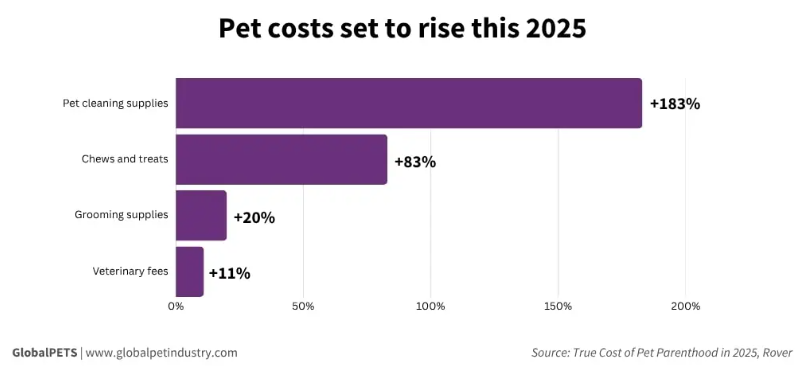The cost of pet ownership is under pressure due to inflation and tariff risk, with pet parents facing significant price rises.
According to a survey of 1,000 US cat and dog owners by online pet marketplace Rover, the cost of treats, chews, grooming and pet cleaning supplies has spiked in the last year.
Lifetime costs
Over the average lifetime for a dog (10 years), the cost of ownership in 2025 is approximately $34,550 (€32K), up as much as 7% from the previous year. For cats with an average lifespan of 16 years, the cost of $32,170 (€30K) may add up to 10% to their total expenses.
However, the averages mask significantly higher costs for larger breeds or pets that exceed the typical lifespan. This can take the lifetime cost of dog ownership to more than $52,000 (€48K) and to above $61,500 (€57K) for a cat.
Tariff risk
Given the current headline-grabbing economic and geopolitical concerns, almost half of respondents expressed concern about the rising costs of being a pet parent, with more than half worried that tariffs will exacerbate this. 3 in 10 fears not being able to afford the items their pet needs right now.
While the cost-of-living crisis has impacted most areas of consumers' budgets, the survey reveals that 31% of participants feel that pet supply costs have increased more than other household or personal care products.
According to Rover's research, pet cleaning supplies (+183%), chews and treats (83%), grooming supplies (+20%) and veterinary fees (+11%) are among the costs set to rise this year.

Tight budgets
Rover's True Cost of Pet Parenthood Report found that 69% of pet parents' budgets were spent on pet food and treats.
But with such a strong commitment to their pets, a third of respondents have cut back on their own groceries or entertainment to prioritize spending on their pets, and a similar percentage say that pet spending is one of the last items they would cut if budgets were tight.
A quarter of pet parents have sought more affordable pet food or pet care, although most (68%) are keen to provide their pets with products and services comparable in quality to those purchased for themselves or loved ones.
However, prospective pet parents should be realistic about the costs involved and perhaps have an emergency fund to meet unexpected expenses, such as vet fees.
When it comes to choosing a pet, pet parents say factors like size (52%), breed (52%) and cost (35%) had an impact on deciding which pet to bring home.
Upfront costs
There is also the upfront cost, although the survey reveals this as one area where there has been some easing. In 2025, bringing a dog home can range from $1,150 (€1.1K) to $4,420 (€4.1K), and a new cat can cost between $750 (€695) and $2,715 (€2.5K), although this is likely due to a reduction in adoption rates.
Welcoming a new dog into the family from an adoption center costs 19% less this year than in 2024, while a cat is 16% less.
Around half of the survey respondents said the cost of bringing a pet home was within their budget, 27% said it was higher than expected and 21% found it to be lower.
Source: GlobalPets
You could be interested: Alltech and Suizo Argentina Announce Strategic Joint Venture
Market Information
18/07/2025
USDA Moves to Rescind Organic Pet Food Standards Just Months After Adoption
04/07/2025
















































